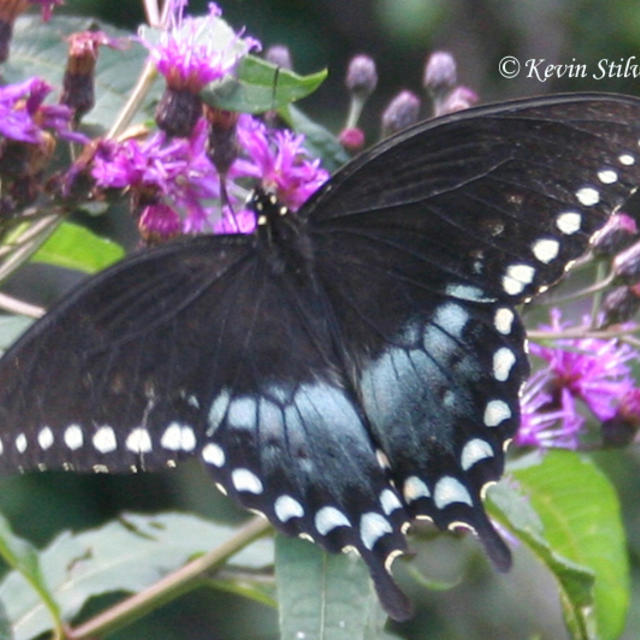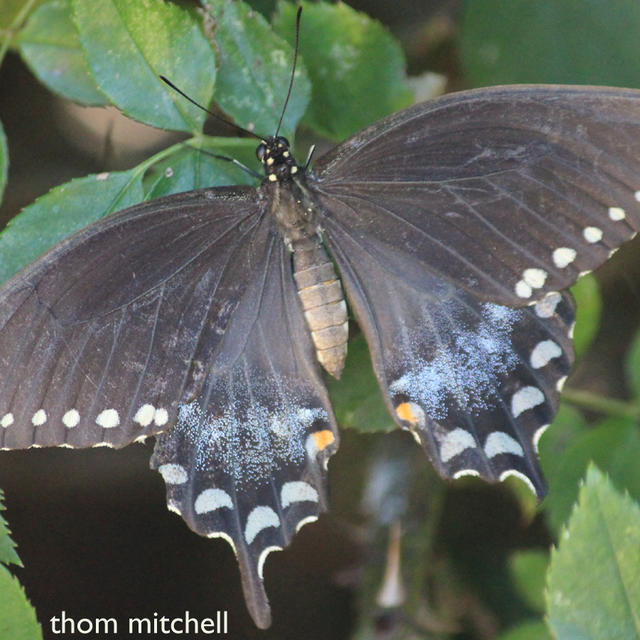Spicebush Swallowtail
Papilio troilus Linnaeus, 1758
Family: Papilionidae
Subfamily: Papilioninae
Identification: Upper surface of forewing is mostly black with ivory spots along margin. Upper surface of hindwing has orange spot on costal margin and sheen of bluish (female) or bluish-green (male) scales. Underside of hindwing with pale green marginal spots.
Wing Span: 3 - 4 inches (7.5 - 10 cm).
Life History: Males patrol in woods, roads and woodland edges to find receptive females. Females lay single eggs on underside of host plant leaves. Caterpillars live in shelters of folded-over leaves and come out to feed at night. Some chrysalids from each generation hibernate.
Flight: 2 generations per year from April-October. In Florida, several generations between March-December.
Caterpillar Hosts: Spicebush (Lindera benzoin), sassafras trees (Sassafras albidum); perhaps prickly ash (Zanthoxylum americanum), tulip tree (Liriodendron tulipifera), sweetbay (Magnolia virginiana), camphor (Cinnamomum camphora), and redbay (Persea borbonia).
Adult Food: Nectar from Japanese honeysuckle, jewelweed, thistles, milkweed, azalea, dogbane, lantana, mimosa, and sweet pepperbush.
Habitat: Deciduous woodlands, fields, roadsides, yards, pine barrens, wooded swamps, and parks.
Range: Eastern states from southern Canada to Florida; west to Oklahoma and central Texas. Occasionally strays to North Dakota, central Colorado, and Cuba.
Conservation: Not usually required.
NCGR: G5 - Demonstrably secure globally, though it may be quite rare in parts of its range, especially at the periphery.
Management Needs: None noted.
BAMONA Shop
Please donate!
We depend on donations to keep Butterflies and Moths of North America freely available. We want to express our gratitude to all who showed their support by making a contribution this year. You can donate to support this project at any time.
Advertise with us!
Do you have a product or service that you think would interest BAMONA users? If you would like to advertise on this website, contact us by email, or use the contact form and select the "Advertising" category.
Verified Sightings
Displaying 1 - 24 of 7862 verified sightings

Observation date: Aug 12, 2025
Submitted by: jmgesell
Region: Dare County, North Carolina, United States
Verified by: Dennis Forsythe
Verified date: Aug 13, 2025

Observation date: Aug 11, 2025
Submitted by: leskokid
Region: Monroe County, Illinois, United States
Verified by: rogerdowner
Verified date: Aug 12, 2025

Observation date: Jul 19, 2025
Submitted by: actuallyamagpie
Region: Clermont County, Ohio, United States
Verified by: rogerdowner
Verified date: Aug 10, 2025

Observation date: Aug 08, 2025
Submitted by: Chrismcd
Region: Berkshire County, Massachusetts, United States
Verified by: jwileyrains
Verified date: Aug 09, 2025

Observation date: Aug 08, 2025
Submitted by: Chrismcd
Region: Berkshire County, Massachusetts, United States
Verified by: jwileyrains
Verified date: Aug 09, 2025

Observation date: Aug 07, 2025
Submitted by: sherdelune
Region: Wicomico County, Maryland, United States
Verified by: jwileyrains
Verified date: Aug 07, 2025

Observation date: Aug 03, 2025
Submitted by: polylepis
Region: Jasper County, Texas, United States
Verified by: jwileyrains
Verified date: Aug 05, 2025

Observation date: Aug 02, 2025
Submitted by: SweetMama70
Region: Putnam County, New York, United States
Verified by: jmgesell
Verified date: Aug 03, 2025

Observation date: Aug 01, 2025
Submitted by: RLS
Region: Monroe County, New York, United States
Verified by: jmgesell
Verified date: Aug 02, 2025

Observation date: Jul 26, 2025
Submitted by: Daniel Morton
Region: Morris County, New Jersey, United States
Verified by: jwileyrains
Verified date: Jul 30, 2025

Observation date: Jul 24, 2025
Submitted by: jwileyrains
Region: Connecticut, United States
Verified by: jwileyrains
Verified date: Jul 24, 2025

Observation date: Jul 15, 2023
Submitted by: beverlynantz
Region: Harlan County, Kentucky, United States
Verified by: CA Ivy
Verified date: Jul 21, 2025

Observation date: Jul 12, 2025
Submitted by: acb22
Region: Sangamon County, Illinois, United States
Verified by: rogerdowner
Verified date: Jul 19, 2025

Observation date: Jul 18, 2025
Submitted by: Daniel Morton
Region: Morris County, New Jersey, United States
Verified by: jwileyrains
Verified date: Jul 19, 2025

Observation date: Jul 13, 2025
Submitted by: Colleen K
Region: Robertson County, Tennessee, United States
Verified by: James Steen
Verified date: Jul 14, 2025

Observation date: Aug 13, 2024
Submitted by: Daniel Morton
Region: Somerset County, New Jersey, United States
Verified by: jwileyrains
Verified date: Jul 13, 2025

Observation date: Jul 27, 2024
Submitted by: Daniel Morton
Region: Warren County, New Jersey, United States
Verified by: jwileyrains
Verified date: Jul 13, 2025

Observation date: Jul 27, 2024
Submitted by: Daniel Morton
Region: Sussex County, New Jersey, United States
Verified by: jwileyrains
Verified date: Jul 13, 2025

Observation date: Sep 04, 2023
Submitted by: Daniel Morton
Region: Somerset County, New Jersey, United States
Verified by: jwileyrains
Verified date: Jul 13, 2025

Observation date: May 31, 2023
Submitted by: Daniel Morton
Region: Warren County, New Jersey, United States
Verified by: jwileyrains
Verified date: Jul 13, 2025

Observation date: Jul 31, 2022
Submitted by: Daniel Morton
Region: Union County, New Jersey, United States
Verified by: jwileyrains
Verified date: Jul 13, 2025

Observation date: Jul 14, 2022
Submitted by: Daniel Morton
Region: Morris County, New Jersey, United States
Verified by: jwileyrains
Verified date: Jul 13, 2025

Observation date: May 31, 2022
Submitted by: Daniel Morton
Region: Union County, New Jersey, United States
Verified by: jwileyrains
Verified date: Jul 13, 2025

Observation date: Jun 05, 2017
Submitted by: Rob Williams
Region: Leon County, Florida, United States
Verified by: curtis.lehman
Verified date: Jul 12, 2025
- 1 of 328
- next ›














